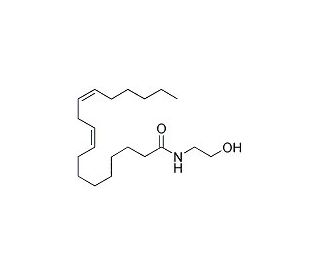

Linoleylethanolamide (CAS 68171-52-8)
QUICK LINKS
Linoleylethanolamide is an inactive analog of anandamide. Linoleylethanolamide is an endocannabinoid detected in porcine brain and murine peritoneal macrophages which contains linoleate in place of the arachidonate moiety of arachidonyl ethanolamide (AEA). It has weak affinity for the cannabinoid 1 (CB1) and CB2 receptors. In addition, linoleoyl ethanolamide increases ERK phosphorylation and AP-1-dependent transcription. However, cellular toxicity is readily apparent at concentrations of 10-20 µM. Linoleylethanolamide inhibits human fatty acid amide hydrolase-dependent hydrolysis of AEA but also is hydrolyzed effectively by the enzyme. Linoleylethanolamide is an N-(long-chain-acyl)ethanolamine that is the ethanolamide of linoleic acid. It has a role as an fatty acid amide hydrolase inhibitor. It is a N-(long-chain-acyl)ethanolamine, a N-(polyunsaturated fatty acyl)ethanolamine and a N-acylethanolamine 18:2. It derives from a linoleic acid. Anandamide (18:2, N-6), also known as linoleamide mea or linoleoylethanolamide, belongs to the class of organic compounds known as n-acylethanolamines. N-acylethanolamines are compounds containing an N-acyethanolamine moiety, which is characterized by an acyl group is linked to the nitrogen atom of ethanolamine. Thus, anandamide (18:2, N-6) is considered to be a fatty amide lipid molecule. Anandamide (18:2, N-6) is considered to be a practically insoluble (in water) and relatively neutral molecule. Anandamide (18:2, N-6) has been primarily detected in blood. Within the cell, anandamide (18:2, N-6) is primarily located in the membrane (predicted from logP). Anandamide (18:2, N-6) can be biosynthesized from linoleic acid.
Linoleylethanolamide (CAS 68171-52-8) References
- Structure-activity relationship for the endogenous cannabinoid, anandamide, and certain of its analogues at vanilloid receptors in transfected cells and vas deferens. | Ross, RA., et al. 2001. Br J Pharmacol. 132: 631-40. PMID: 11159715
- Lauroylethanolamide and linoleoylethanolamide improve functional outcome in a rodent model for stroke. | Garg, P., et al. 2011. Neurosci Lett. 492: 134-8. PMID: 21296126
- Role of anorectic N-acylethanolamines in intestinal physiology and satiety control with respect to dietary fat. | Hansen, HS. 2014. Pharmacol Res. 86: 18-25. PMID: 24681513
- Lipoxygenase-derived 9-hydro(pero)xides of linoleoylethanolamide interact with ABA signaling to arrest root development during Arabidopsis seedling establishment. | Keereetaweep, J., et al. 2015. Plant J. 82: 315-27. PMID: 25752187
- Relationship Between Circulating Fatty Acids and Fatty Acid Ethanolamide Levels After a Single 2-h Dietary Fat Feeding in Male Sprague-Dawley Rats : Elevated levels of oleoylethanolamide, palmitoylethanolamide, linoleoylethanolamide, arachidonoylethanolamide and docosahexanoylethanolamide after a single 2 h dietary fat feeding in male Sprague Dawley rats. | Olatinsu, AO., et al. 2017. Lipids. 52: 901-906. PMID: 29032410
- Ethanolamides of essential α-linolenic and linoleic fatty acids suppress short-term food intake in rats. | Ho, M., et al. 2020. Food Funct. 11: 3066-3072. PMID: 32191234
- Steric stabilisers govern the colloidal and chemical stability but not in vitro cellular toxicity of linoleoylethanolamide cubosomes. | Mohammad, Y., et al. 2020. Colloids Surf B Biointerfaces. 192: 111063. PMID: 32353710
- Cytokines and Lipid Mediators of Inflammation in Lungs of SARS-CoV-2 Infected Mice. | Dubuc, I., et al. 2022. Front Immunol. 13: 893792. PMID: 35812400
- Fatty acid amide hydrolase and 9-lipoxygenase modulate cotton seedling growth by ethanolamide oxylipin levels. | Arias-Gaguancela, O., et al. 2023. Plant Physiol. 191: 1234-1253. PMID: 36472510
- Two new unsaturated fatty acid ethanolamides in brain that bind to the cannabinoid receptor. | Hanus, L., et al. 1993. J Med Chem. 36: 3032-4. PMID: 8411021
Ordering Information
| Product Name | Catalog # | UNIT | Price | Qty | FAVORITES | |
Linoleylethanolamide, 10 mg | sc-203107 | 10 mg | $225.00 | |||
Linoleylethanolamide, 100 mg | sc-203107A | 100 mg | $800.00 |
